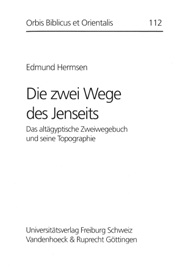
The First Intermediate Period marks the first decisive break in the religious history of ancient Egypt. The Coffin Texts - including of course the Book of Two Ways - grew out of the effort to come to terms with the crisis resulting from collapse of the Old Kingdom. All 22 copies of the Book of Two Ways derive from the necropolis EI Bersha; its rock tombs belonged to members of the ruling family and princely household of the nome of Hermopolis. Fourteen owners of the coffins can be identified by name. The Book of Two Ways dates from the first half of dynasty twelve, during which the nome's rulers reigned with relative autonomy. The main cult site in Hermopolis was the temple of Thot; like the pharaos, the princes of the nome designated themselves as sons of Thot.
The Book of Two Ways is preserved in two versions. lt is divided into eight sections, each with a topography of the beyond, these topographies varying from one another. The three preeminent gods of the Book of Two Ways are Re, Osiris, and Thot. The map section, the heart of the Book of Two Ways, has a clear dual structure based on two distinct ways, a blue way by water and a black way on land. These are separated by a red lake of flame, which corresponds to the cosmic myth of Hermopolis. The way by water embraces both the region of day and that of night (as against Lesko, who assumes that the map section contains a cosmological plan).
Starting on the land route, the deceased is towed on the lake of flames in the bark of the sun. In this lake of flames occurs the regeneration of the sun god as well as that of the deceased. Indeed, if the Book of Two Ways holds out a goal, this is to be sought in the lake of flames.
The final section (IX) closes with the famous dictum 1130 containing the speech of the All-Lord. In this the sun god gives an answer to thereproach to God , that is to say, here are the beginnings of a solution to the religious crisis of the First Intermediate Period. One of the things the text yields is a different conception of the afterlife: the deceased will be like Re in the East of the heavens and like Osiris within the underworld. Of course this Statement is not to be taken as evidence of any 11 democratization in the other world but rather as an enlargement of the concept integrating the new members of the power hierarchies of the nome principalities.
Composed as it is of a text with illustrations, the Book of Two Ways represents the oldest attempt in ancient Egypt to conceive of the beyond in a topographical fashion. Its cartographic structure holds spellbound the dangers of an unknown world. This new conception draws on the cult topography of Hermopolis. The Book of Two Ways was propably written by priests in the temple library of the temple of Thot in Hermopolis.
Through its innovative composition as an illustrated text and by virtue of its well developed topography of the afterlife, it provides a link between the Pyramid Texts of the Old Kingdom and the underworld books and the Book of the Dead of the New Kingdom. The Book of Two W ays altered permanently the tradition of conceptions of the afterlife in ancient Egyptian culture.

